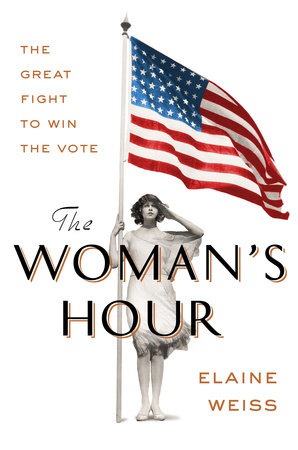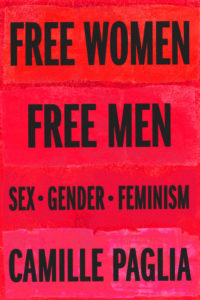 Camille Paglia captures all her best provocations, smoke bombs, and sturdy anti-establishmentarianism in this collection of essays, opening with excerpts from her hefty and admittedly groundbreaking Sexual Personae (1990) and ending with recent publications on Salon.com affirming her stance on abortion and the sadomasochism of high heels.
Camille Paglia captures all her best provocations, smoke bombs, and sturdy anti-establishmentarianism in this collection of essays, opening with excerpts from her hefty and admittedly groundbreaking Sexual Personae (1990) and ending with recent publications on Salon.com affirming her stance on abortion and the sadomasochism of high heels.
As usual, Paglia prides herself on being strident, combative, and anti-mainstream, advocating her personal brand of “dissident,” “Amazonian feminism” and promising she is the “60s come back to haunt the present.” At some points it begins to feel like Paglia’s counter-culturalism has become a sheer reflex. If it’s a majority opinion, she’s going to refute it, and pride herself that her combative instincts (gifted her, she suggests, by her Italian-American descent) have guided her to a truth that the myopic, misguided, spineless crowd is too duped to see or too dim to understand.
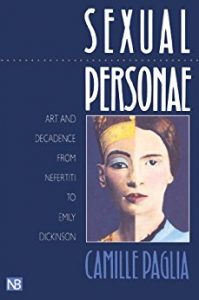 The relentless self-satisfaction and feelings of superiority aside, Paglia’s intellectual endeavors of the past 27 years are full of striking common sense. Abortion, she declares, should be legal on the sheer fact of constitutional rights. She’ll concede pro-lifers the moral high ground, given their feelings about the sanctity of life, but she comes down staunchly libertarian on this political spectrum. Madonna, she noticed early on, is a “real” feminist: “She shows girls how to be attractive, sensual, energetic, ambitious, aggressive, and funny—all at the same time” (50).
The relentless self-satisfaction and feelings of superiority aside, Paglia’s intellectual endeavors of the past 27 years are full of striking common sense. Abortion, she declares, should be legal on the sheer fact of constitutional rights. She’ll concede pro-lifers the moral high ground, given their feelings about the sanctity of life, but she comes down staunchly libertarian on this political spectrum. Madonna, she noticed early on, is a “real” feminist: “She shows girls how to be attractive, sensual, energetic, ambitious, aggressive, and funny—all at the same time” (50).
Paglia is a big fan of “independence, self-reliance, personal responsibility, and not blaming other people for your problems” (67). She is an unabashed follower of Dionysus and the ideals of beauty and pleasure, preferring de Sade to Rousseau, Freud to Lacan, Wilde to Wollstonecraft. She likes the aggression and athleticism of American football, admires the aesthetic of gay men, and appreciates pornography for its celebration of sexual impulse and its melding of danger and eroticism. Sex is dangerous, Paglia asserts, and danger is sexy. That she pointed out this self-evident truth is why, she seems to think, everybody got on her case over S.P.
 Paglia gets less pleasure out of celebrating the things she does like, however, than she does out of bashing the things she hates. Paglia’s praise is warm but mild, but her glee when she holds the sledgehammer is glorious to behold. Most of the book is a strident and, by the end, well-rehearsed tirade against the same set of targets: mainstream Western feminism (“Infirmary Feminism”) and feminists, with their “moldy neuroses,” women’s studies centers, poststructuralist theory (oh, how Paglia loathes poststructuralism! she trots out her best insults on this rampage), and the Victorian coddling of college students over date rape.
Paglia gets less pleasure out of celebrating the things she does like, however, than she does out of bashing the things she hates. Paglia’s praise is warm but mild, but her glee when she holds the sledgehammer is glorious to behold. Most of the book is a strident and, by the end, well-rehearsed tirade against the same set of targets: mainstream Western feminism (“Infirmary Feminism”) and feminists, with their “moldy neuroses,” women’s studies centers, poststructuralist theory (oh, how Paglia loathes poststructuralism! she trots out her best insults on this rampage), and the Victorian coddling of college students over date rape.
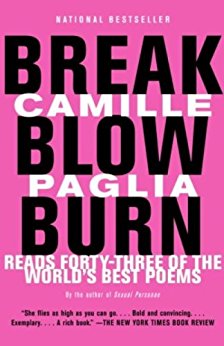 Libertarian as she is, as noted, Paglia fails to see how a good dose of bucking up, showing some backbone, slinging insults, and—in the case of real women leaders, like female presidential candidates—maybe have a little military training can not immediately solve the problems women have created for themselves by being born into a world where men have invented technology, culture, government, sports, and fashion. Paglia might be more persuasive if she were more inclined to negotiate, consider all sides, explore, rethink, and potentially compromise—best seen in her lecture at MIT, when she howls with outrage over a presentation she had to sit through with a feminist scholar critiquing fashion photography. Beauty is all! Paglia says, not ever considering how a young and impressionable girl might be led to decades of hating and disfiguring her own body because she doesn’t live up to these highly managed and curated images. But Paglia is having too much fun to put down the sledgehammer, and besides, she hates sissies.
Libertarian as she is, as noted, Paglia fails to see how a good dose of bucking up, showing some backbone, slinging insults, and—in the case of real women leaders, like female presidential candidates—maybe have a little military training can not immediately solve the problems women have created for themselves by being born into a world where men have invented technology, culture, government, sports, and fashion. Paglia might be more persuasive if she were more inclined to negotiate, consider all sides, explore, rethink, and potentially compromise—best seen in her lecture at MIT, when she howls with outrage over a presentation she had to sit through with a feminist scholar critiquing fashion photography. Beauty is all! Paglia says, not ever considering how a young and impressionable girl might be led to decades of hating and disfiguring her own body because she doesn’t live up to these highly managed and curated images. But Paglia is having too much fun to put down the sledgehammer, and besides, she hates sissies.
Though her running patter on the history of second wave feminism, her antipathy for Gloria Steinem, her admiration for women like Amelia Earhart and Katherine Hepburn and Germaine Greer, and her John-the-Baptist sense of being the prophetic voice crying out in the wilderness start to feel worn and well-used by their last iterations (though one has to admire Paglia for her consistency), this book is still a must-read for anyone who calls themselves a feminist. For one thing, her history of feminism, though highly condensed, is highly useful, especially where she finds it infused with nineteenth century utilitarianism and eighteenth century Romanticism.
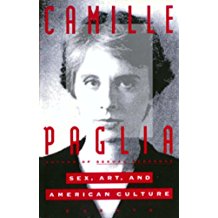 For another, Paglia’s critique of women’s studies programs and the way academic feminists train other academic feminists deserves some serious consideration. Her plea to inject some self-possession and some real common sense—and some basic knowledge of science, including biology—into mainstream feminism should be taken seriously, too. Last but not least, her prose, even when she’s at her most insulting, has a spare, lithe, powerful beauty. The book is simply fun to read, occasional howlers aside.
For another, Paglia’s critique of women’s studies programs and the way academic feminists train other academic feminists deserves some serious consideration. Her plea to inject some self-possession and some real common sense—and some basic knowledge of science, including biology—into mainstream feminism should be taken seriously, too. Last but not least, her prose, even when she’s at her most insulting, has a spare, lithe, powerful beauty. The book is simply fun to read, occasional howlers aside.
And her ultimate call—that feminism create a path for real, tangible equality for all genders, no matter what they are—is, after all, femmeliterate’s goal, too. So on that—even though I suspect Paglia would consign me and this site as party to the sniveling, vegetable-crisper School of Feminism—I’m on her side. I wish I were teaching a gender studies class next semester so that I could assign this book.

